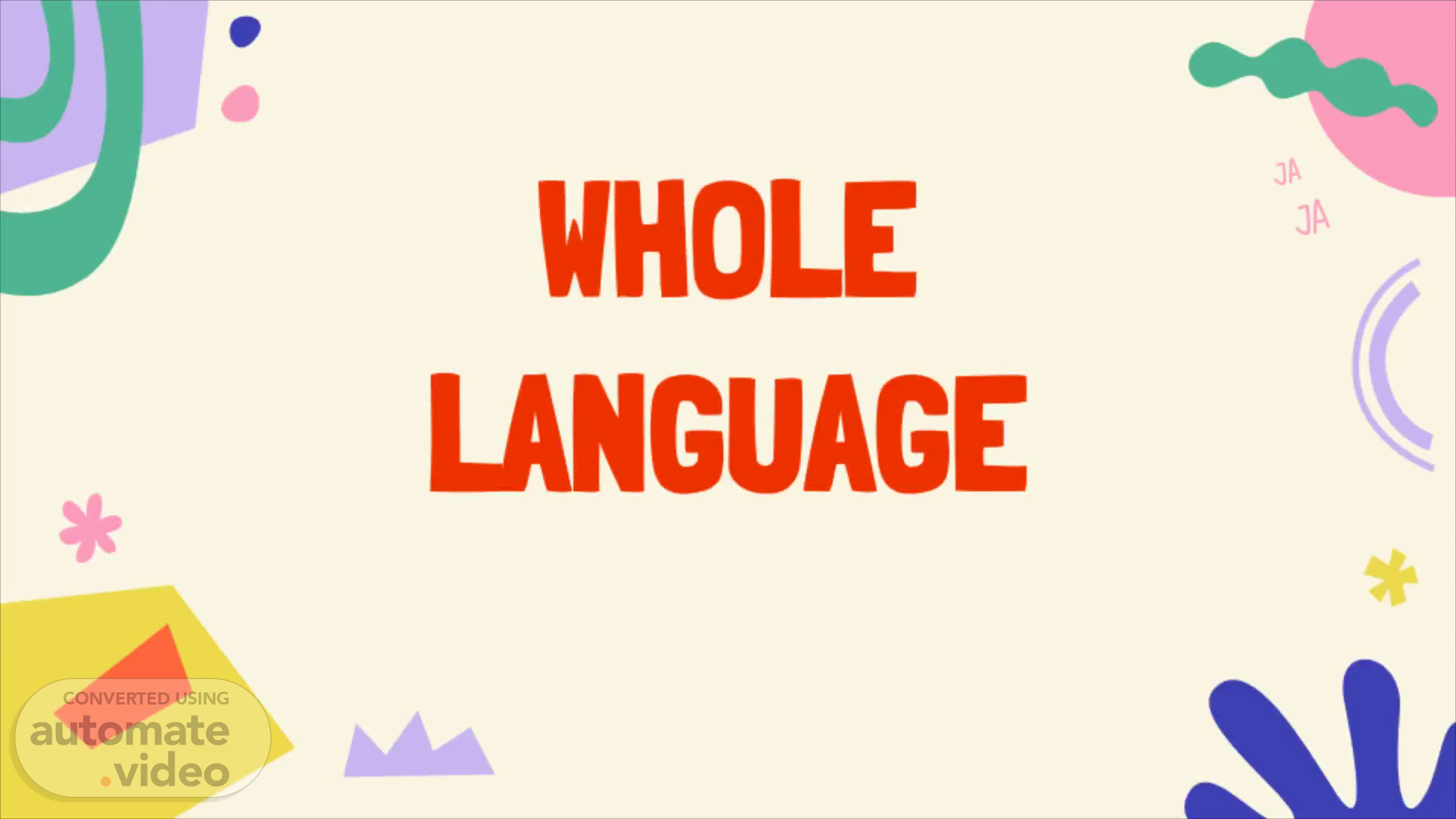
PowerPoint Presentation
Scene 1 (0s)
W HOLE LANGUAGE.
Scene 2 (6s)
4 Classroom Features Bergeron (1990). The use of literature.
Scene 3 (18s)
ACTIVITIES THAT ARE OFTEN USED IN WHOLE LANGUAGE INSTRUCTION Writing Individual and small group reading and writing conferences Upgraded dialogue journals. Student made books Story writing.
Scene 4 (30s)
Whole Language activities are also common in other instructional approach , such as CLT, CBI and Task-Based Language Teaching. What differs in Whole Language teaching is not the incidental use such activity based on the topic of the lesson or an item in the syllabus but their use as part of an overall philosophy in teaching and learning that gives a new meaning and purpose to activities. The following is an example of literary pieces in a Whole language workshop and involves activities built around the use of “Parallel Texts “ Two English translations of the same short story is an example of parallel texts..
Scene 5 (57s)
Parallel Texts: Opening Sentences from two translations of a Korean Short Story 1a. “Cranes” by Hwang-Sun-Won (translated by Kevin O’Rourke) The village on the Northern side of the 38 th parallel frontier was ever so quiet and desolate beneath the high, clear autumn sky. White gourds leaned on white gourds as they swayed in the yard if an empty house..
Scene 6 (1m 15s)
1b. “The Crane” by Hwang-Sun-Won (translated by Kim-Se-Young) “The northern village at the boarder of the 38 th Parallel was ever so snug under the bright high autumn sky. In the space between the two main rooms of the empty farm hous e a white empty gourd was lying against another white empty gourd.”.
Scene 7 (1m 33s)
Examples of student activities based on parallel texts: 1. Think of the village as described in 1a and 1b as two different villages. Which one would you choose to live in? 2. Do the contrasting and opening sentences set up any different expectations in the reader as to what kind of story will follow and what the stone of the story will be? 3. On a map of Korea, each partner should indicate where he/she thinks the village is located. Are the locations the same? If not, why not? 4. Write an opening sentence of a short story in which you briefly introduce the village of 1a as it might appear in winter rather than autumn. 5. Write two parallel text opening sentences in which you describe in different words a village you know. Ask a partner which village he/she prefers. 6. Discuss what different kinds of stories might follow on the basis of the opening sentences. Write an original first sentence of this story thinking of yourself as “translator” and drawing on both translations as your resources..
Scene 8 (2m 17s)
The Whole Language movement was advocated not as a teaching method but as an approach to learning that sees language as whole entity. In language teaching, each language teacher was free to implement the approach according to the need of particular classes. Advantages claimed for Whole Language are that it focuses on experiences and activities that are relevant to learner’s lives and needs, that is uses authentic materials, and that is can be used to facilitate the development of all aspects of a second language. This approach to reading instruc tion continue to be widely used in the primary grades in U.S Schools, despite having been disproven time and again by careful research and evaluation..
Scene 9 (2m 47s)
Almost every premised advanced by whole language about how reading is learned has been contradicted by scientific investigations that have established the following facts: Learning to read is a natural process Our alphabetic writing system is not learned simply from exposure to print. Spoken language and written language are very different The most important skill in early reading is the ability to read single words, completely, accurately and fluently. Context is not the primary factor in word recognition..
Scene 10 (3m 9s)
Thomas B. Fordham Foundation 2002 suggest how Whole Language can be “rooted out” from reading classrooms, and lists several recommendations including the following: Every state should have language-arts content standards and curricular frameworks for each grade from kindergarten through third grade that are explicitly based on solid reading-research findings. State assessments should be calibrated to show the effects of reading instruction as delineated in well-written state standards. State accountability systems should emphasize the attainment of grade appropriate reading, spelling, and writing skills by third grade..
Scene 11 (3m 34s)
References: Aaron, P. 1991 Is there a whole in language? Contemporary Education 62 (Winter):127 Adunyarittigun , D. 1996. Whole Language: A Whole New World for ESL Programs, ERIC Document Bergeron, BS. 1990. What does the term Whole Language mean? Journal of Reading Behavior 22(4):6-7 Brockman, B. 1994. Whole Language: A Philosophy of Literary Teaching for Adults Too! ERIC Document Chitrapu , D. 1996, Whole Language: Adapting the Approach for Large Classes, Forum Magazine 34(2): 28—29 Goodman, K. 1986. Wh at’s Hole in the Language? Porstmouth , NH: Heinemann. Hao, R.N. 1991. Whole Language: Some Thoughts Kamchmacha Journal of Education (March):16-18 Heymsfield , C.R. 1989, Filling the hole in Language. Educational Leadership. 46(6) Krashen, S. 1998. Has Whole Langauge Failed? ERIC Document Lems , K 1995. Whole Language and the ESL/EFL Classroom ERIC Document (ED384210).
Scene 12 (4m 15s)
THANK YOU!.